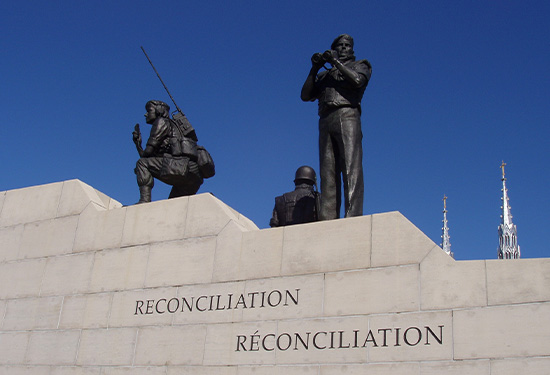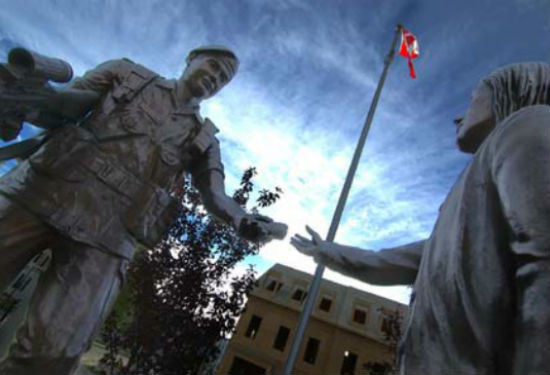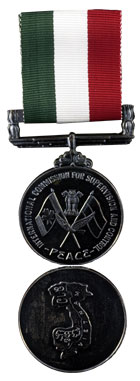More than a thousand Canadian Armed Forces members served in Cambodia to help stabilize and rebuild the country during four peace support missions between 1954 to 2000. They took part in United Nations and other international community efforts there to help the people of this war-torn land.
Cambodia stories
Season 5: Service and sacrifice across generations - Faces of Freedom Podcast - Veterans Affairs Canada (Episode two - Bettina Fuchs podcast)
Tony Beresford – Heroes Remember videos – Veterans Affairs Canada
Cambodia is a tropical country in Southeast Asia. It has an area of approximately 180,000 km2 (about three times the size of Nova Scotia) and a population of nearly 17 million people. It is one of the poorest countries in Asia, and borders Vietnam, Laos and Thailand. Cambodia was once a part of French Indochina, a colony that France founded in the 1800s which dissolved after the Second World War.

Canadian peacekeepers visiting a Cambodian orphanage in the early 1990s. Photo: Department of National Defence ISC92-1200
A tough road to independence
Cambodia became an independent country in 1953 after the end of the French colonial rule. Conflict continued in the country for several reasons. For example, there were political struggles as communist and non-communist groups in Cambodia fought for control. Also, at times, the Vietnam War would also spill over into Cambodia. Then in 1975, the Khmer Rouge faction gained power and renamed the country Kampuchea. Cambodians faced four years of terror. Under this communist regime, an estimated two million Cambodians died from famine, sickness, forced labour and execution.
Vietnam invaded Cambodia in 1978 and forced the Khmer Rouge regime from power the following year. Unrest and violence continued in the country, however, as resistance groups and the Vietnamese fought for control.
A new chapter begins
In the late 1980s, Vietnam announced it would finally withdraw from the country. A new chapter in Cambodia’s history began, which Canada and the international community helped bring about.
The world responds
International Commission for Supervision and Control
Canada’s first military efforts in Cambodia began in 1954. About 30 Canadians went there as part of the International Commission for Supervision and Control (ICSC) to help enforce the Geneva Accords. This military mission helped French Indochina transition to becoming three new countries—Cambodia, Laos and Vietnam. In Cambodia, Canadian peacekeepers played several roles. They helped maintain order and supervised the withdrawal of French colonial forces and those from neighbouring countries. The mission’s international personnel watched for border violations in the volatile region. They also monitored the first elections in Cambodia as a new country.
The ICSC mission soon reduced in size. After a few years, only a handful of Canadian Armed Forces members still served there. In 1969, the last ICSC troops left the country.

A United Nations boat conducting a patrol on the Mekong River in Cambodia. Photo: Department of National Defence ISC92-1054
United Nations Advance Mission in Cambodia
In late 1991, Canadian Armed Forces members returned to Cambodia. This time, they joined international efforts to help the war-torn country after the horrors of the Khmer Rouge regime and the ensuing Vietnamese occupation and civil war.
The United Nations Advance Mission in Cambodia (UNAMIC) helped put in place a long-awaited peace agreement and pave the way for a larger UN mission to come. Canadians were part of this initial mission. They monitored the delicate cease-fire and worked in landmine awareness, training and removal. Canadian military engineers played a key role in clearing landmines in this war-torn country. After decades of conflict, the Cambodian land had millions of these deadly, hidden weapons.
United Nations Transitional Authority Cambodia mission
In early 1992, the massive United Nations Transitional Authority Cambodia (UNTAC) mission began. As one of the UN’s largest ever peace support efforts, more than 20,000 military and police personnel from over 40 countries joined this mission. These peacekeepers monitored the cease-fire and disarmed the fighting sides. They also oversaw the repatriation of hundreds of thousands of Cambodian refugees in time for a national election.
Canada’s role
About 700 Canadian Armed Forces members served with UNTAC between February 1992 and September 1993. While they made up only a small portion of the UN force, these experienced Canadians shared a great asset: their extensive peacekeeping knowledge.
At any given time, about 240 Canadian Armed Forces members served there in several roles. A key job was a challenging one. They transported supplies and the thousands of UN personnel around a Cambodia. At the time, there was still guerrilla activity in the country and wide-spread armed robbery in some regions. The No. 92 Transport Company delivered food, fuel, natural gas, election supplies and other goods the UN needed.

A Canadian peacekeeper distributing toys to children in Cambodia. Photo: Department of National Defence ISC92-1096
Canadians offered other logistical support, such as finding accommodations for the huge UN force. Many of our peacekeepers were bilingual—a great asset as English and French were spoken in many of the countries contributing UN troops. Some Cambodians spoke French, as a result of decades of colonial rule.
Thirty Canadian sailors served with UN naval detachments. They patrolled the Gulf of Thailand and the Mekong River to monitor refugee movements. They also watched for cease-fire violations, smugglers and bandits. Another 40 Canadian officers served with the UN command in the country.
The UNTAC mission closed in 1993. The last Canadian peacekeepers left the country in November.

A Canadian Armed Forces transport truck on the move in Cambodia in 1992. Photo: Department of National Defence ISC92-1043
The Cambodia Mine Action Centre
Cambodia has one of the heaviest concentrations of land mines in the world. It’s estimated four to six million land mines have killed 15,000 people and injured 120,000 more. Between 1994 and 2000, more than 60 Canadian Armed Forces members returned to the country to work with the Cambodia Mine Action Centre. They helped find and remove deadly land mines—a UN task that continues there to this day.

A member of the Cambodian Mine Action Centre team at work in 1997. Photo: Department of National Defence ISC97-4-13
ORDER OF EVENTS
1954
French Indochina transitions into three new countries: Cambodia, Laos and Vietnam
1954
30 Canadian service members join the International Commission for Supervision and Control peace mission in Cambodia.
1975-1979
Following a five-year civil war, the Khmer Rouge regime rules Cambodia
1978-1989
Vietnam occupies Cambodia
late 1991
Canadian Armed Forces (CAF) members join the United Nations Advance Mission in Cambodia (UNAMIC) to help carry out a peace agreement
February 1992 – September 1993
CAF members serve with the United Nations Transitional Authority Cambodia (UNTAC)
1994 – 2000
CAF members return to Cambodia as part of the United Nations Cambodia Mine Action Centre
2000 – present
The United Nations continues to find and remove deadly land mines in Cambodia.
Classroom materials
Classroom materials main page- Date modified:











